Adventure enduro is a holistic discipline. It revolves through the same cycles of preparation, riding and planning the next adventure. Throughout the process, the bike, riding gear and other equipment are continuously perfected. Each day of riding gives more insight; equipment either works or it needs to be rethought. High quality gear, that performs reliably under extreme conditions, is of paramount importance in running successful expeditions.
Tent bag: 1218 g / 2 lb 11 oz, 3.9 litres
Quilt bag: 402 g / 14.2 oz, 3.9 litres
Kitchen bag: 436 g / 15.4 oz, 1.3 litres
Total: 2056 g / 4 lb 8.5 oz, 9.1 litres
The evolution
It’s amusing to look back now at the articles I wrote in early 2015 on camping gear and the mobile kitchen. My “ultralight” camping setup weighed around 4.5 kg (9 lb 15 oz) at the time and probably took over 20 litres of space. Progress has been made since then, and while I still carry some of the equipment from 2015, the total mass and volume have been cut down with over a half.
The reason for slimming down the luggage is the performance of my KTM 500 EXC. It is a very light bike, not designed to carry other loads than the rider. So every kilogram that goes on it, will make it worse on the trail. This is true for every bike of course, but there’s a huge difference between adding 10 kg of luggage on a 110 kg race bike or on a 250 kg adventure bike. The added weight doesn’t make such an impact on the performance of the bigger bike. And either way, unless you’re Chris Birch, the latter is very rarely seen on as technical trails as the former, so the added weight doesn’t matter as much to begin with. However, riding on steep and technical mountain trails or in the soggy Siberian wilderness, weight matters a lot. Low weight is not everything, but it’s definitely crucial.
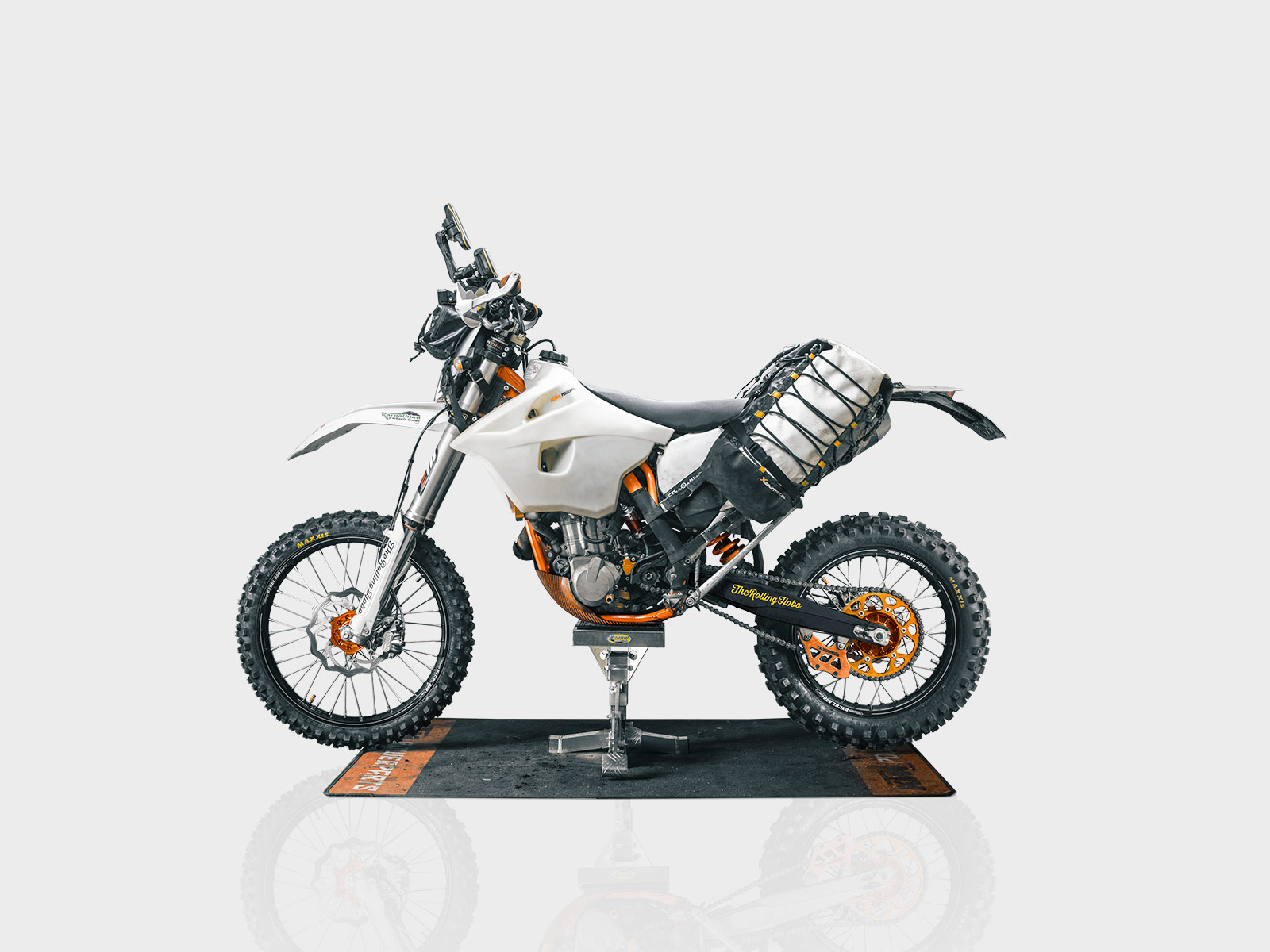
The ultralight house of one
Terra Nova Equipment Laser Photon 1 including poles: 724 g / 1 lb 9.5 oz
Terra Nova Equipment Titanium Pegs, 10 pcs : 14 g / 0.5 oz
Vaude 15,5 cm Titanium Pegs, 6pcs: 48 g / 1.7 oz
Ghetto Tent stakes pouch: 8 g / 0.3 oz
Ghetto Waterproof tent bag: 42 g / 1.5 oz
Total: 836 g / 1 lb 13.5 oz
Mobile shelters vary from sleeping rough under a riding jacket to huge double tents with inside parking for the bike. I tend to gravitate towards the lightest and smallest option and don’t mind sleeping under the stars. However, the prospect of bloodthirsty flying insects flying around will have me packing a tent in a heartbeat. Arguably one could carry a mosquito head net and sleep under an ultralight tarp for rain protection, but I find the added comfort and personal space of a light solo tent worth the extra weight.
I’ve had the Sierra Clip Flashlight for probably around fifteen years, and it’s still going strong. It’s quick and easy to pitch, has plenty of room, a large vestibule and so far it has stood up well against the elements. The only downside is that it weighs around 1.5 kg (3 lb 4.9 oz) and the pack size is 13 x 48 cm which makes it too big for my panniers.
There were several options for solo tents, but few met the criteria of a sub-kilogram weight and a max 42 cm pack length. The clear winner by a huge margin was the Terra Nova Laser Photon 1. The specified max weight is 0.72 kg (1 lb 9.4 oz) with pack dimensions of 10 x 35 cm yielding a pack volume of 2.75 l. The closest rival is the MSR Carbon Reflex 1, which weighs about a hundred grams more than the Laser, but has a much bigger pack size of 13 x 43 cm and pack volume of 5.7 l.
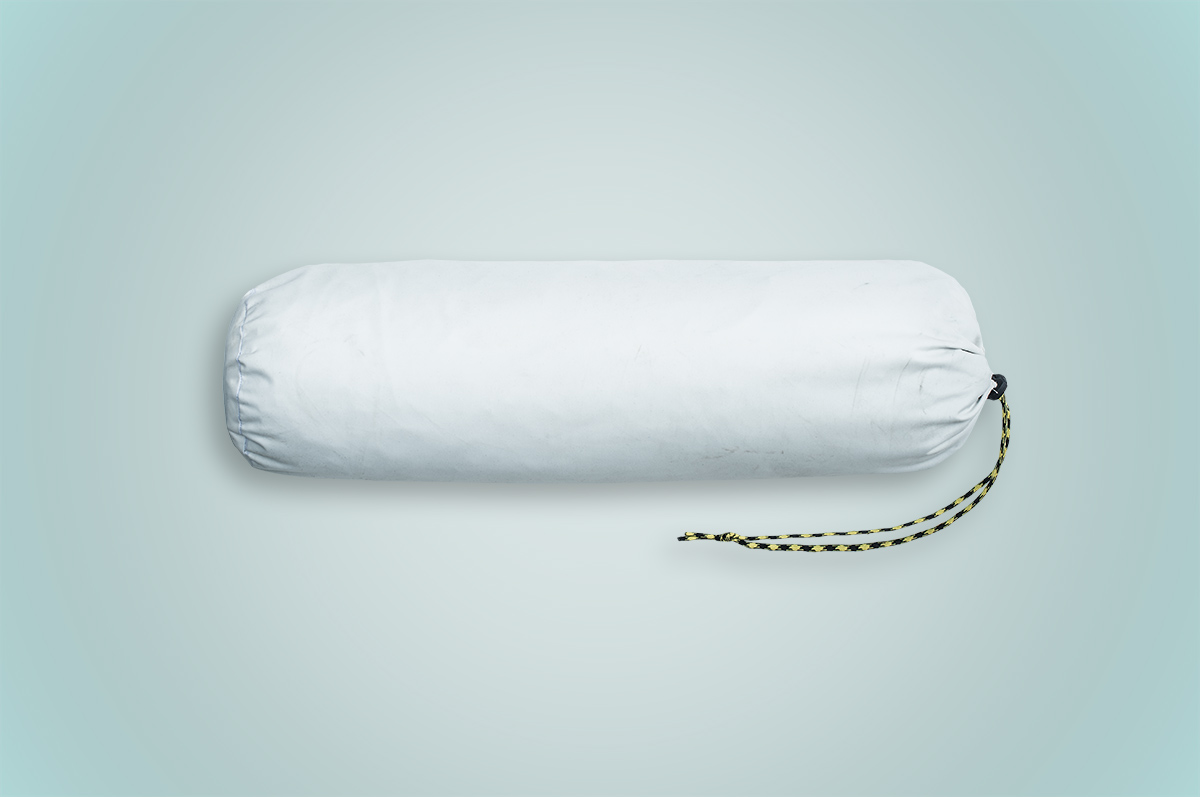
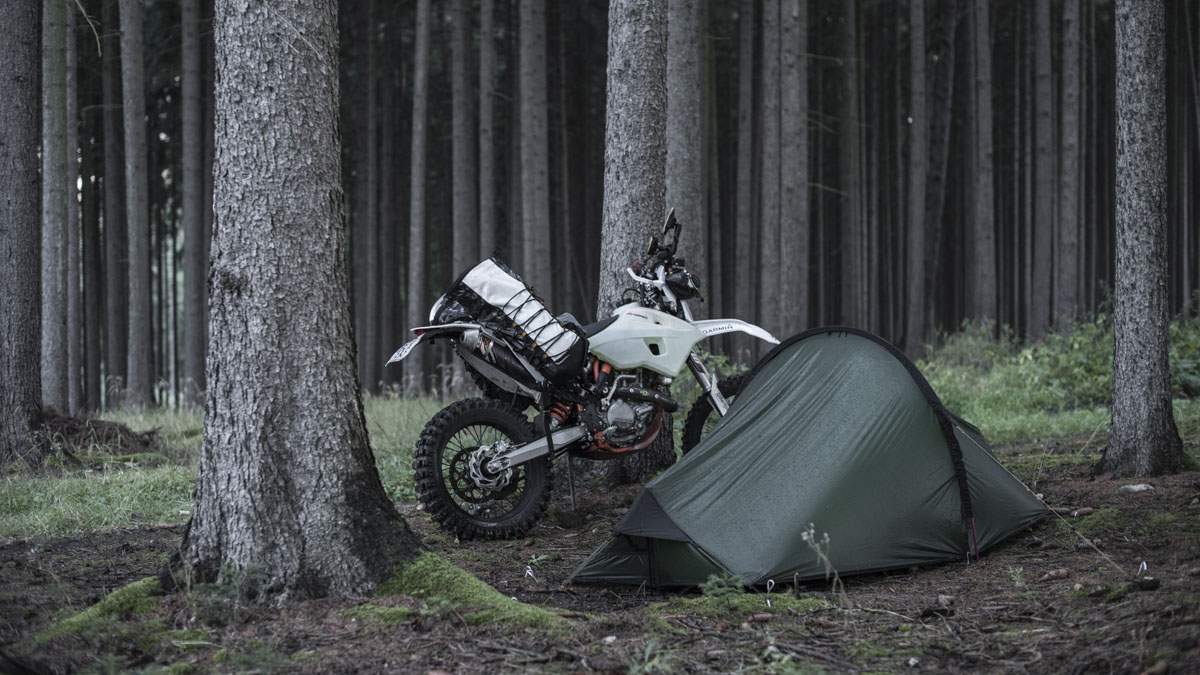
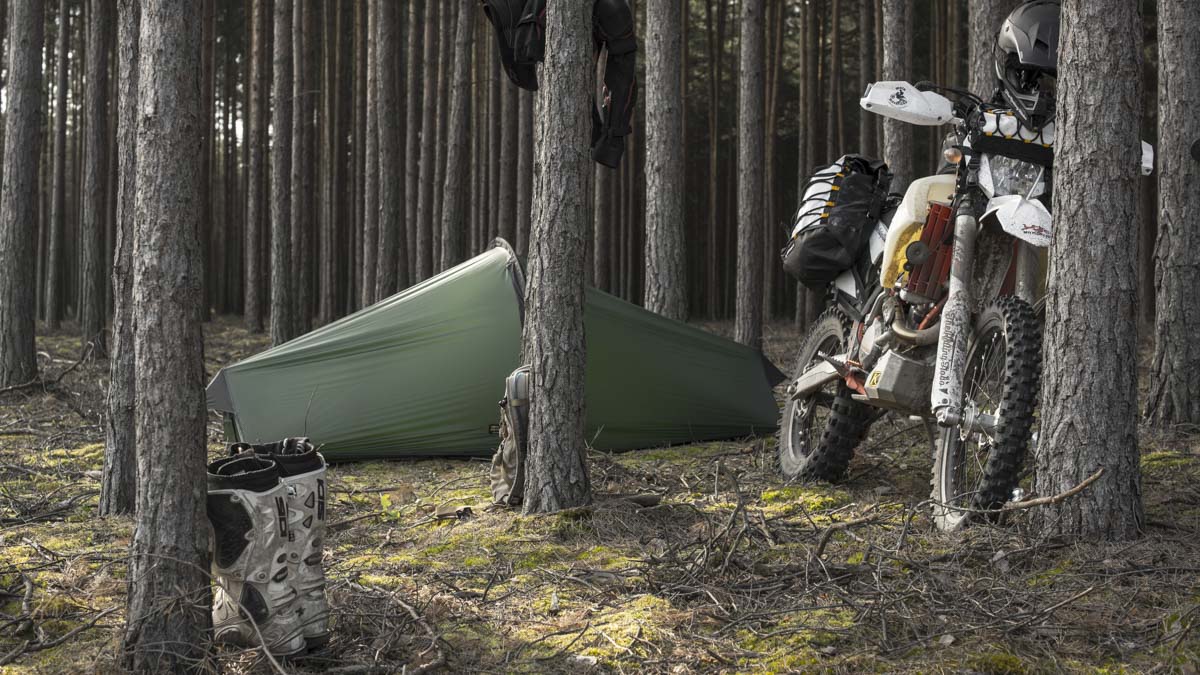
The Laser Photon 1 is made with extremely lightweight materials, which requires some care while handling the tent. Pitching the tent took some getting used to, but once it became routine it didn’t take too long. I’ve left the end poles of the tent fitted permanently which makes pitching the tent faster. The tent included a set of one gram titanium pegs, which are ridiculously small. They are very easy to lose and I doubt that they’d hold in rough weather. So I beefed up the set with six sturdier Vaude titanium pegs, which I use on high stress points of the tent.
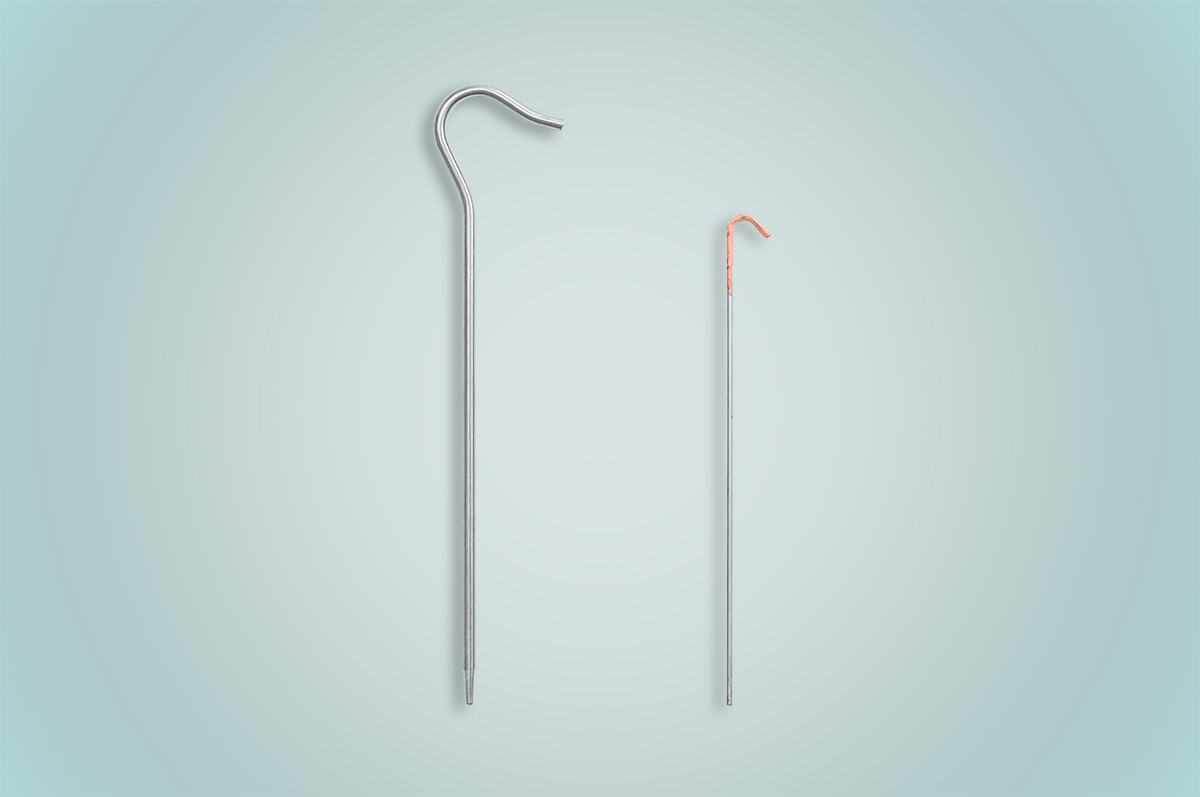
The tent seems sturdy and I don’t expect trouble in rough weather, but it’s always a good idea to take wind direction into account when pitching. I find the sleeping space comfortable and the ventilation works well enough. There is just enough space to sit up and even get geared up while sitting sideways in the tent, if I put my legs out into the vestibule. The vestibule isn’t big, but my riding boots fit there nicely, along with other items that need to stay dry but are unsuitable for inside storage.
The greatest concern I have with the tent is the floor. It’s made from an extremely light fabric, which will wear quickly on rough ground, and will provide very little protection from sharp objects. This issue could be easily countered with a ground sheet, but with an appropriate fabric weight it would add plenty of mass and pack volume, so it seems rather counterproductive.
Due to a plethora of reasons I prefer not to mount things externally on the 500 EXC. However, I also have a rigid rule against placing fluids inside the panniers, which creates a bit of a paradoxical situation, as the tent will most certainly be wet at some point. The problem was countered with a dry bag for the tent. Or I should probably call it a wet bag, as its purpose is containing water inside it. It’s sewed with a light waterproof fabric, which should be rugged enough to hold up against the abrasive life inside the panniers. Just to be sure, I just might place the tent in a plastic bag, prior to packing it into the dry bag.
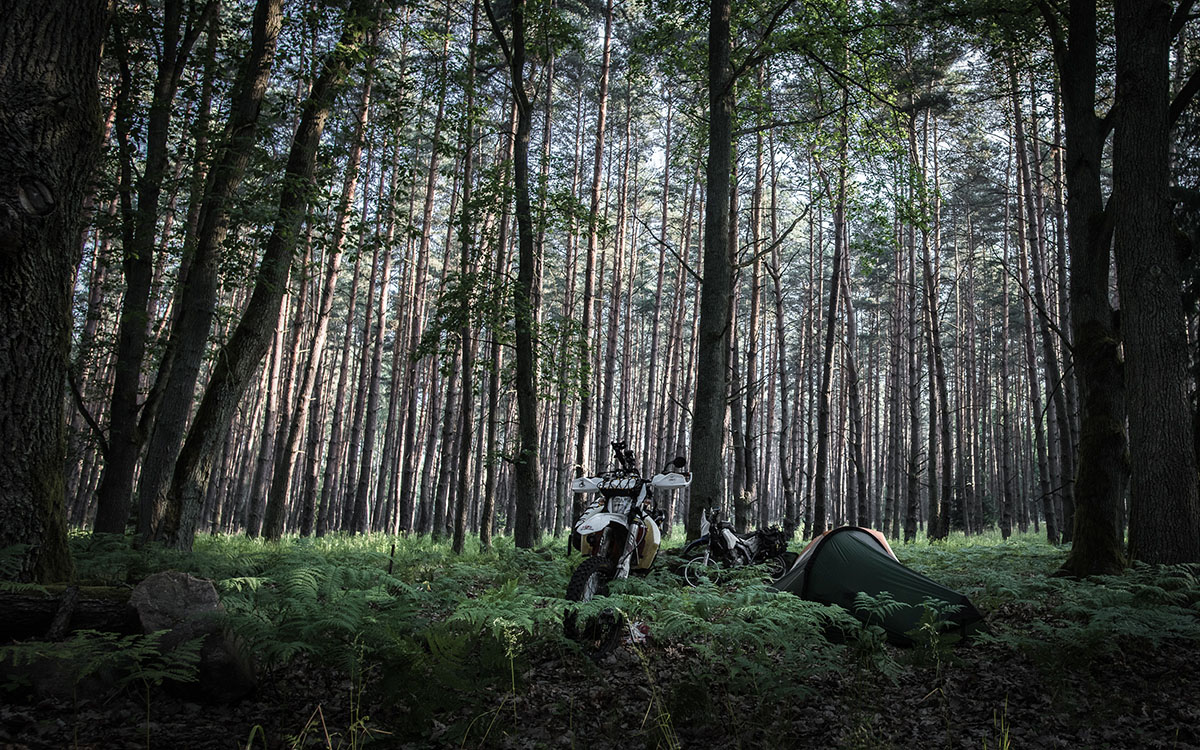
The ultralight sleeping pad
Sea to Summit Ultralight Mat: 382 g / 13.5 oz
Foam sleeping pads are excellent due to their reliability, weight and low cost. However, as I don’t pack things externally onto my bike, and within my double fifteen litre panniers a foam pad would take way too much space, I’m forced to use a compact inflatable pad. So I went with a Sea to Summit Ultralight Mat, which weighs 382 grams (13.5 oz) and packs into 7.5 x 17 cm and 0.75 l, which is absolutely tiny. As it is ultralight and inflatable, it is more prone to punctures so a repair kit is essential. Luckily the Ultralight Mat comes with a repair kit.
As I don’t carry a ground sheet for the tent, extra care must be taken to protect the sleeping pad in rough terrain. I usually place my riding jacket and pants under the sleeping pad, to protect it from sharp objects. To make packing more streamlined, I leave the sleeping pad deflated inside the tent. It will roll up nicely with the tent and ride in its dry bag.
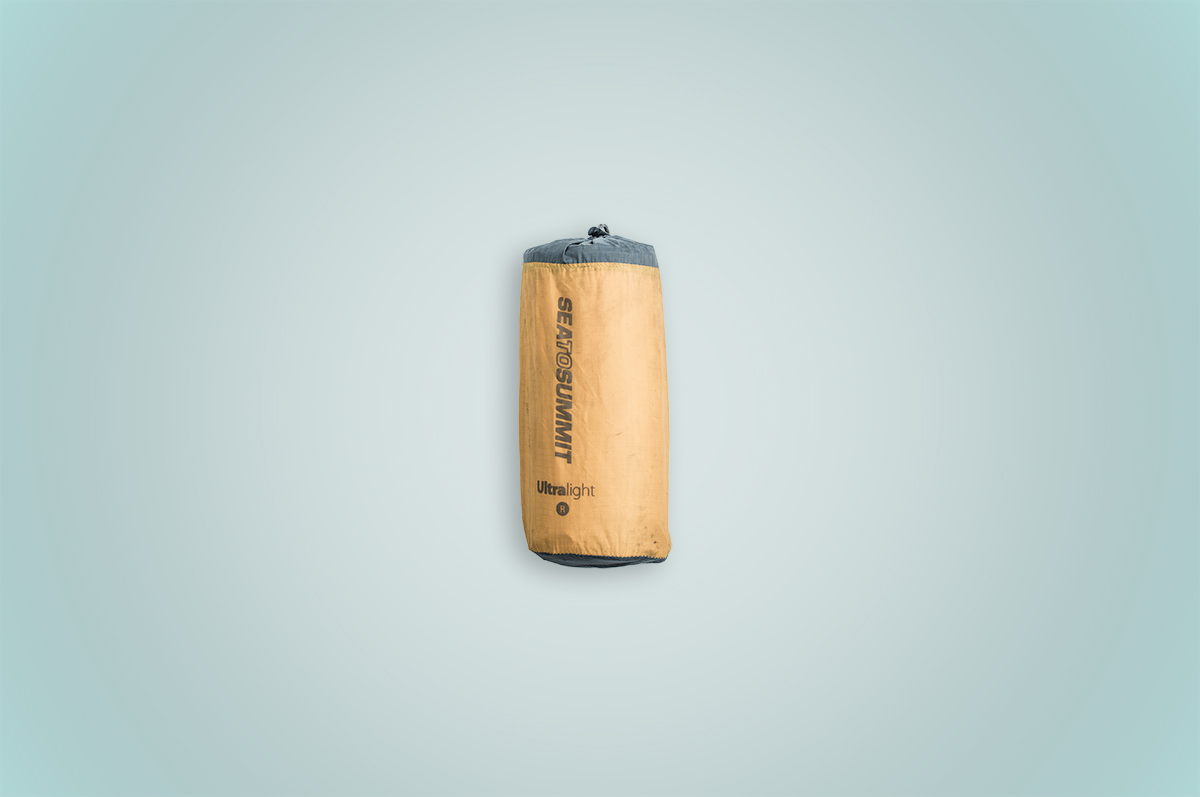
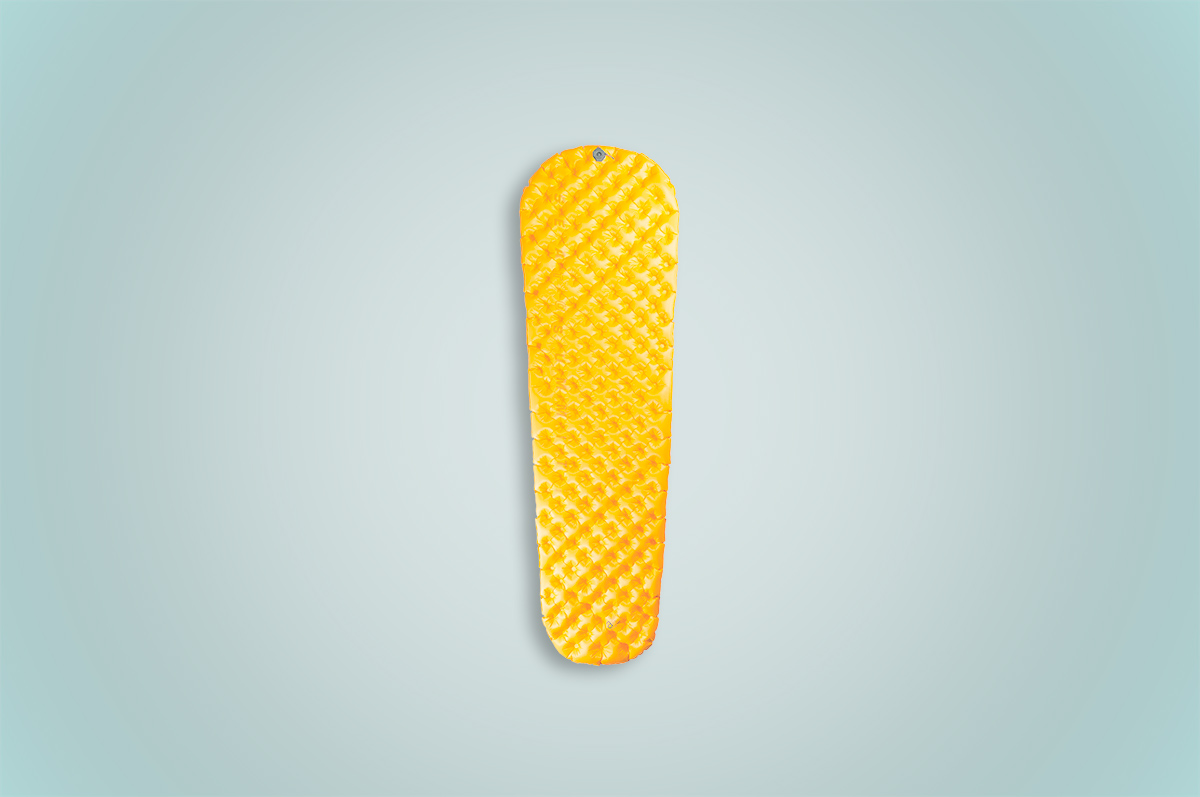
The death of sleeping bags
Enlightened Equipment Enigma down quilt: 376 g / 13.3 oz
Ghetto Waterproof bag: 26 g / 0.9 oz
Total: 402 g / 14.2 oz
One of the heaviest pieces of camping equipment is the sleeping bag, so I decided to get rid of it entirely. I have been keeping an eye on down quilts for a while, and they make a lot of sense to me. In sleeping bags, your body weight squashes a large portion of the insulation, which makes it an ineffective dead mass along with the fabric that holds it in place. Sleeping bags also tend to have a long zipper, which adds weight.
I decided to go with the Enlightened Equipment Enigma down quilt. They are made to order and fully customisable. I specced mine at +5°C with 950 FP down. I believe this will be warm enough for all above freezing conditions, but I went with the long and wide profile, for extra warmth. With colours I went full enduro ninja; the inside fabric is 10D black and the outside is 10D charcoal. My Enigma weighs 376 grams, so close to just a third of the sleeping bag I was carrying before. The quality of the materials and workmanship are excellent.
The Enigma down quilt plays a critical role in more ways than one. As I usually carry no mid layers, the Enigma will be my extra insulation layer on cold evenings in camp and especially during the odd cold night high up in the mountains. The Enigma is also my emergency insulation, so it has to remain dry in all situations. For this reason, I’ve upgraded the original ultralight pouch with a waterproof bag. I sewed it into a long cylindrical shape that fits the profile of my panniers.
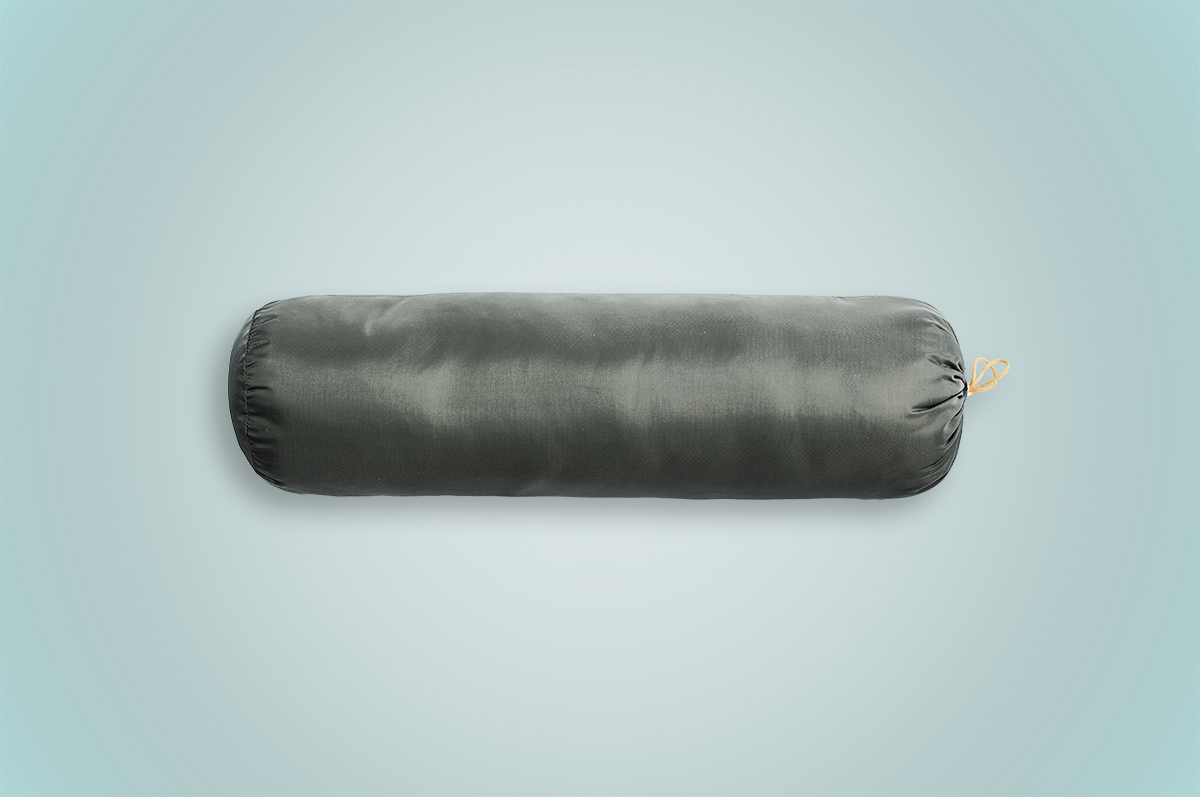
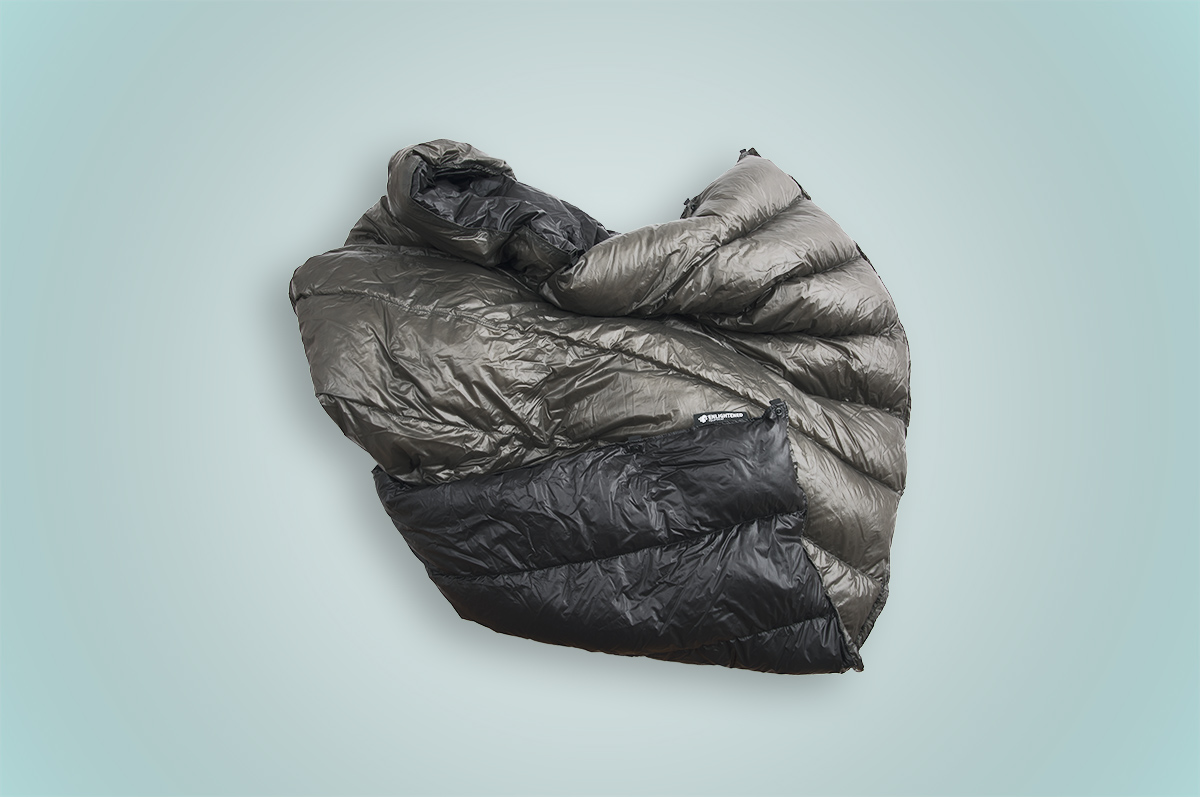
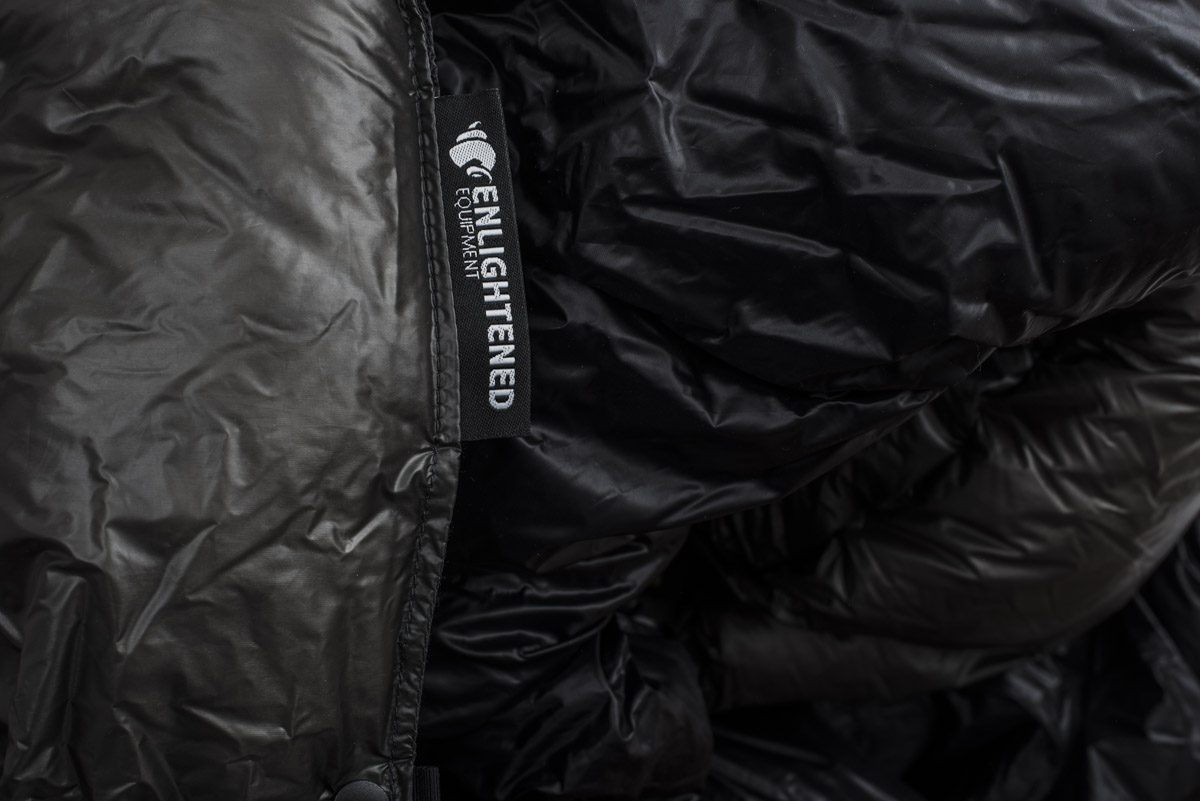
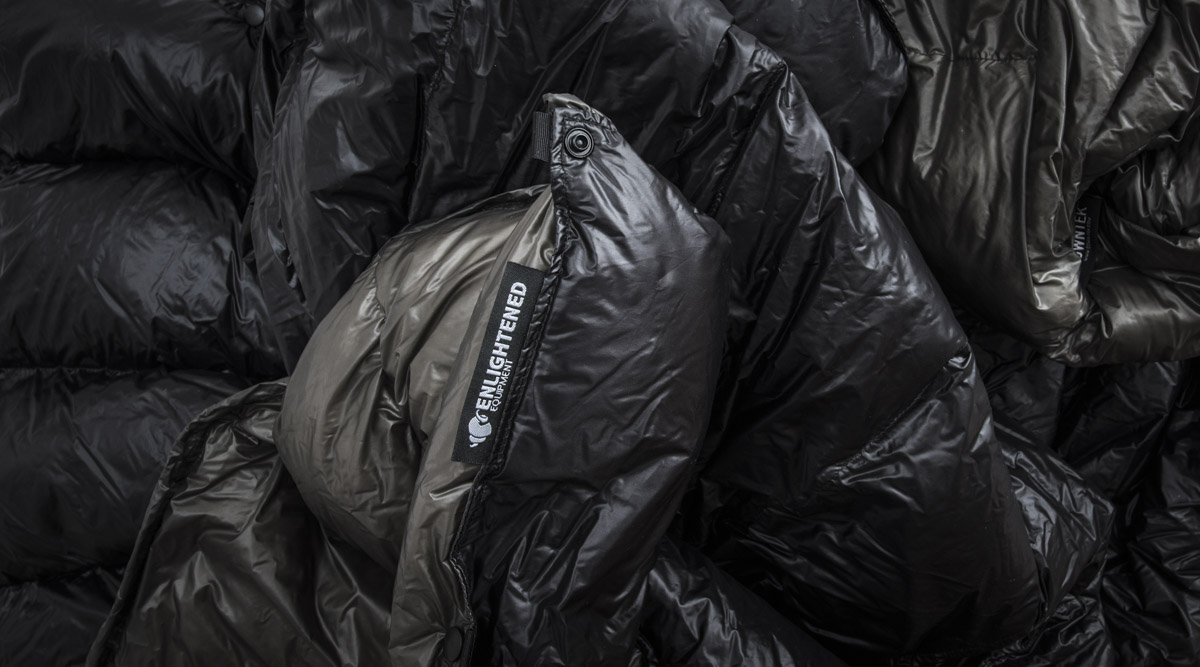
All this for coffee?!
Snow Peak Trek 700 titanium pot and lid: 124 g / 4.4 oz
MSR Pocket Rocket stove: 86 g / 3 oz
MSR Titanium Spoon: 18 g / 0.6 oz
Gas cartridge: 170 g / 6 oz
Lighter: 20 g / 0.7 oz
Ghetto Waterproof pouch: 18 g / 0.6 oz
Total: 436 g / 15.4 oz
I don’t usually cook food in camp, as it makes a mess of the pot and cleaning it requires carrying a washing pad, soap and water. So I usually stick to food that doesn’t require cooking, but I do like to drink coffee in the morning so the stove and pot are essential. Well maybe not essential, but a small piece of luxury, if you will. To be honest, I could easily leave the kitchen behind, but this is too ascetic for some riders I roll with, and I suppose it’s nice to have a portable heat source for when things get…complicated.
The MSR Pocket Rocket may no longer be the lightest stove on the market, but after almost two decades of use, mine still works like a charm. So I see no sense in replacing it, but if I did, it’d be for a Snow Peak LiteMax because of its more compact size and lower weight.
My pot, or drinking mug, is a titanium Snow Peak Trek 700, which fits a small gas cartridge inside it. I also carry an MSR titanium spoon and a standard BIC lighter. I see no need in carrying special survival matches or other fire gadgets, as the BIC lighters are cheap, available anywhere and will remain perfectly dry if stored in a ziploc bag. I pack the stove, lighter, instant coffee and tea bags inside the pot and the gas cartridge on top of it. They all fit nicely into a small 10 x 17 cm DIY pouch with a pack volume of roughly 1.3 litres.
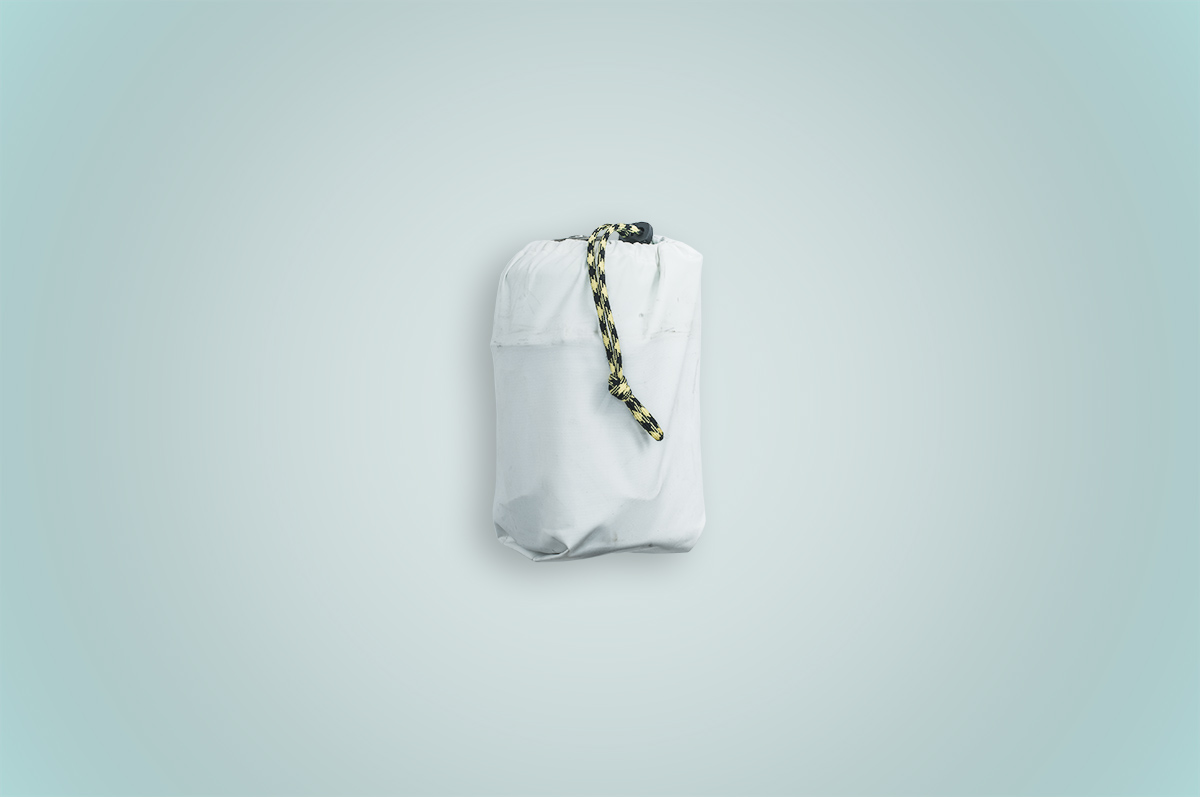
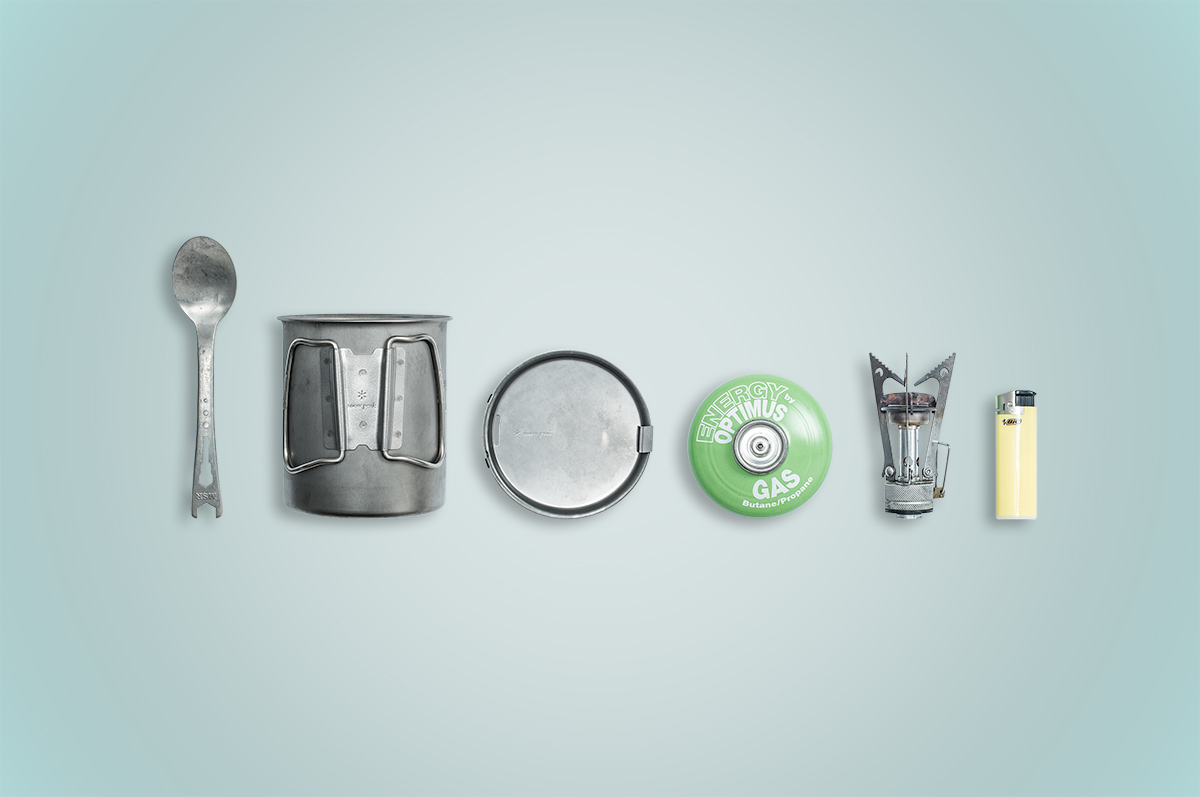
Let me know…
So there it is, the two kilogram camping kit. There is always room for improvement, but at the moment I’m very happy with it. It could of course go even lighter, but the expenses would go up significantly per gram, which does not make it a sensible pursuit to me for now.
Please let me know what you think and what you would have done differently.
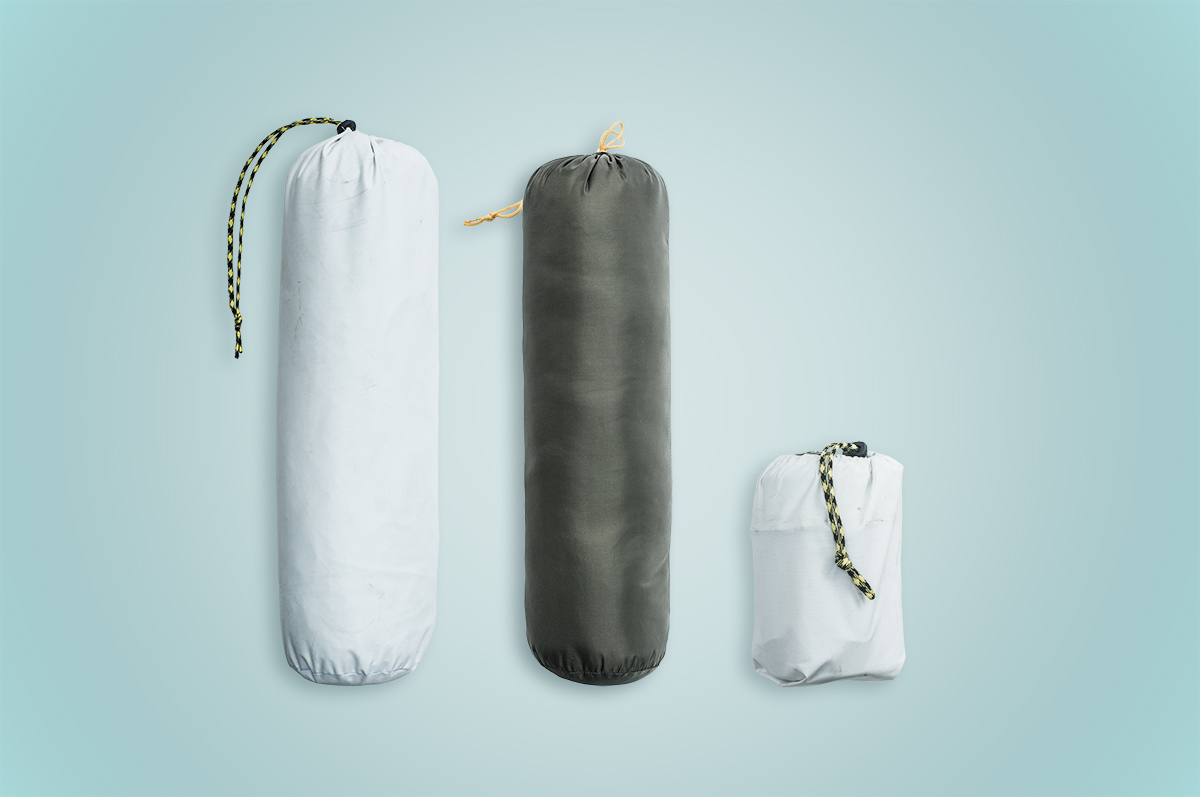
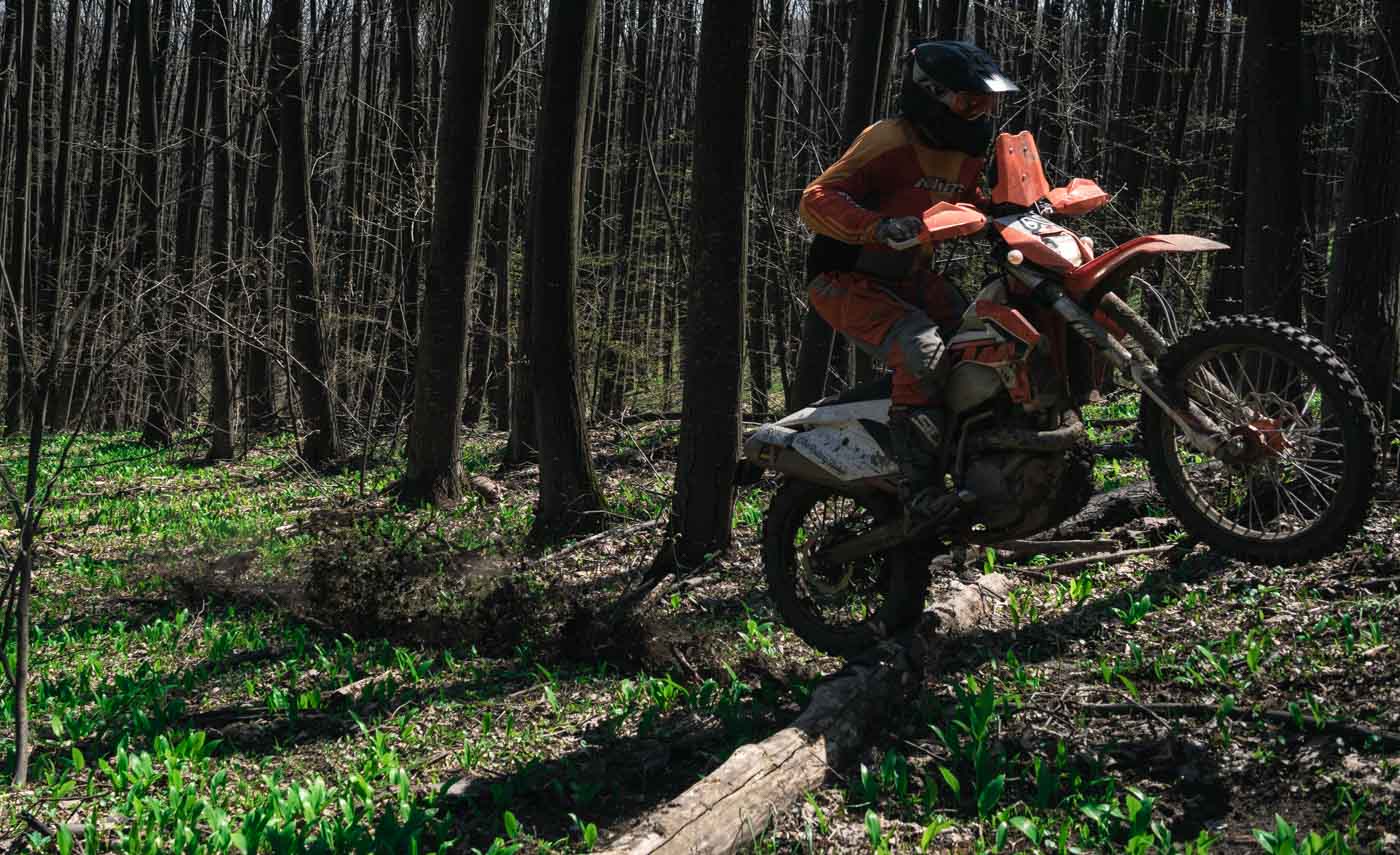
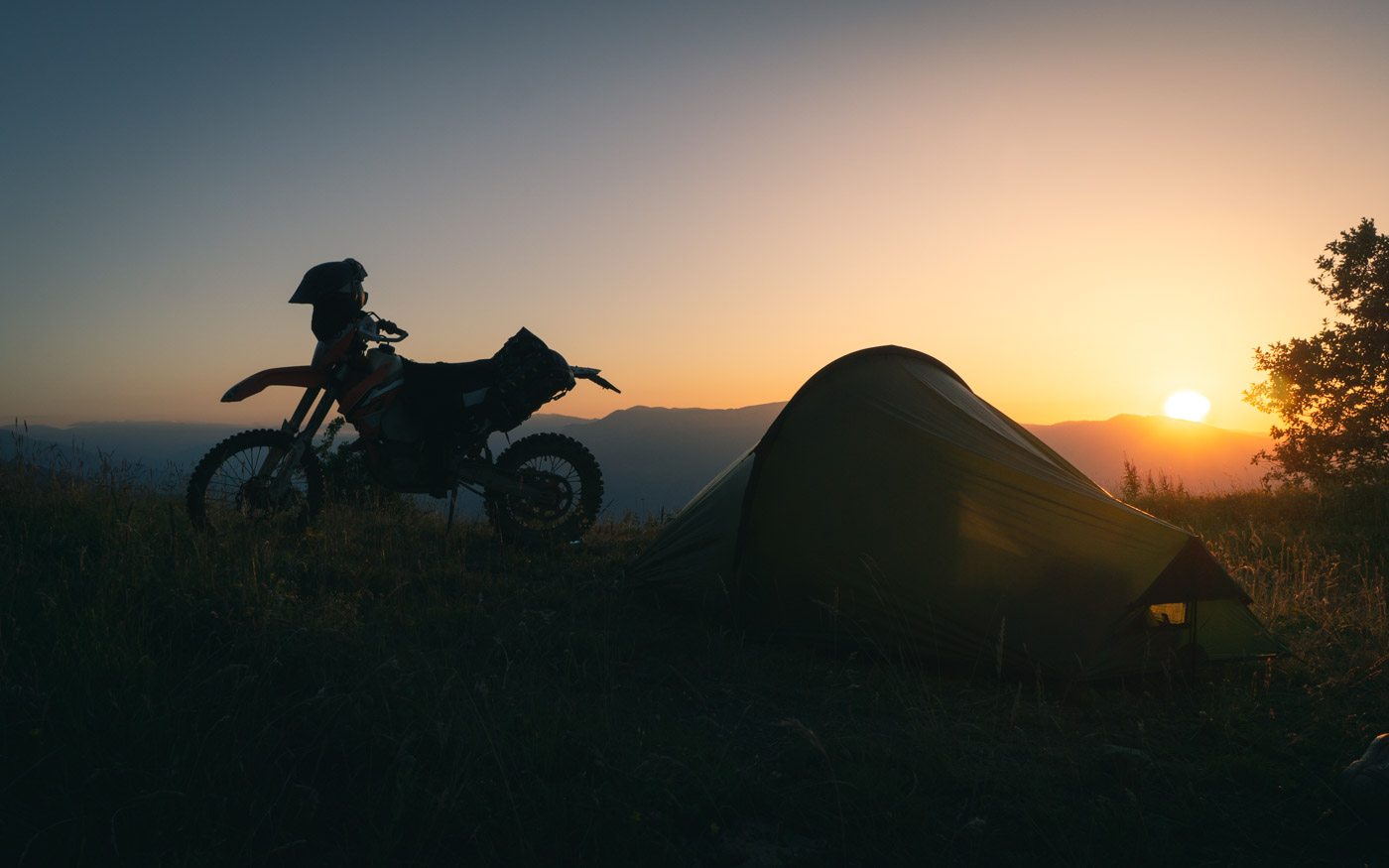
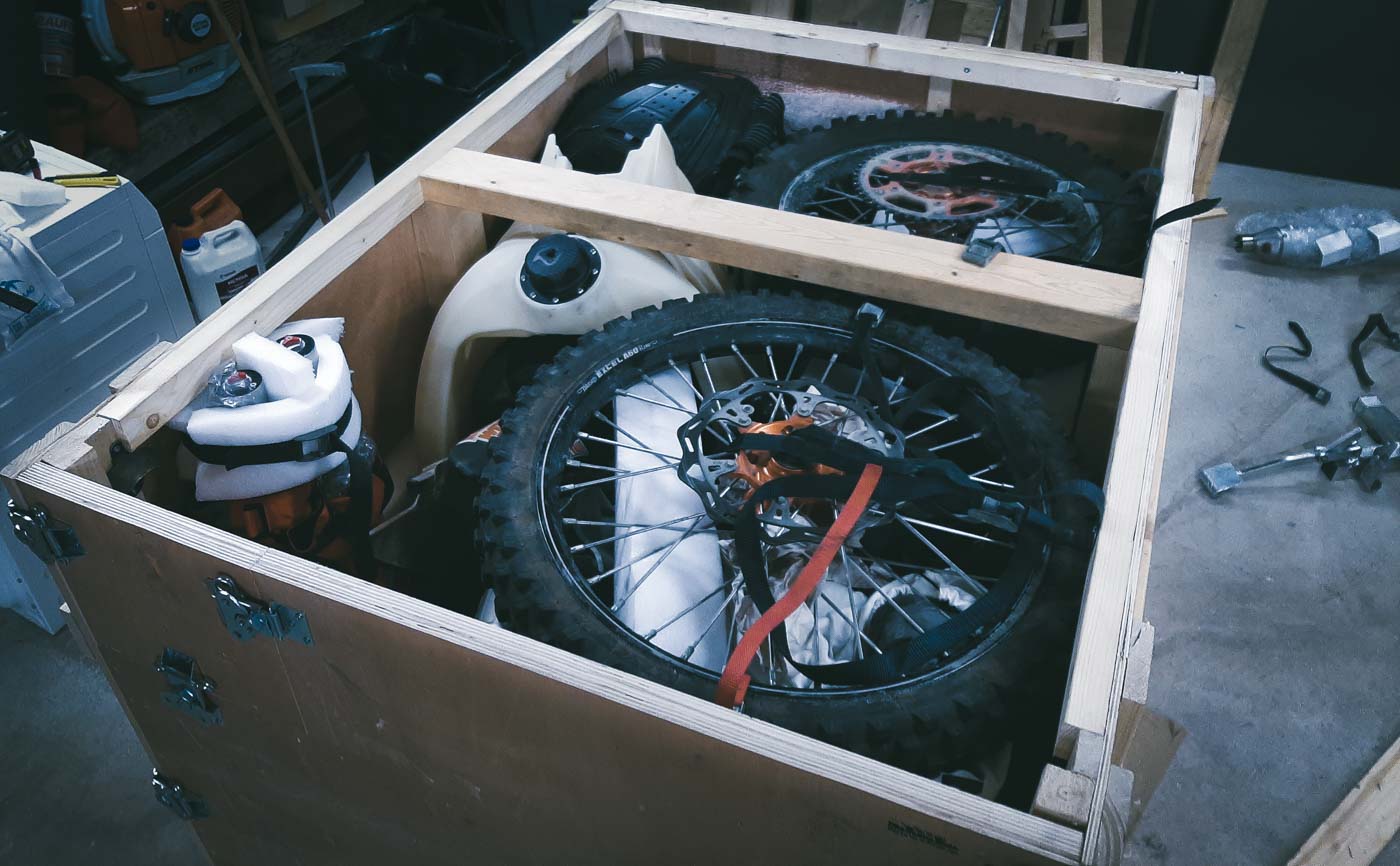
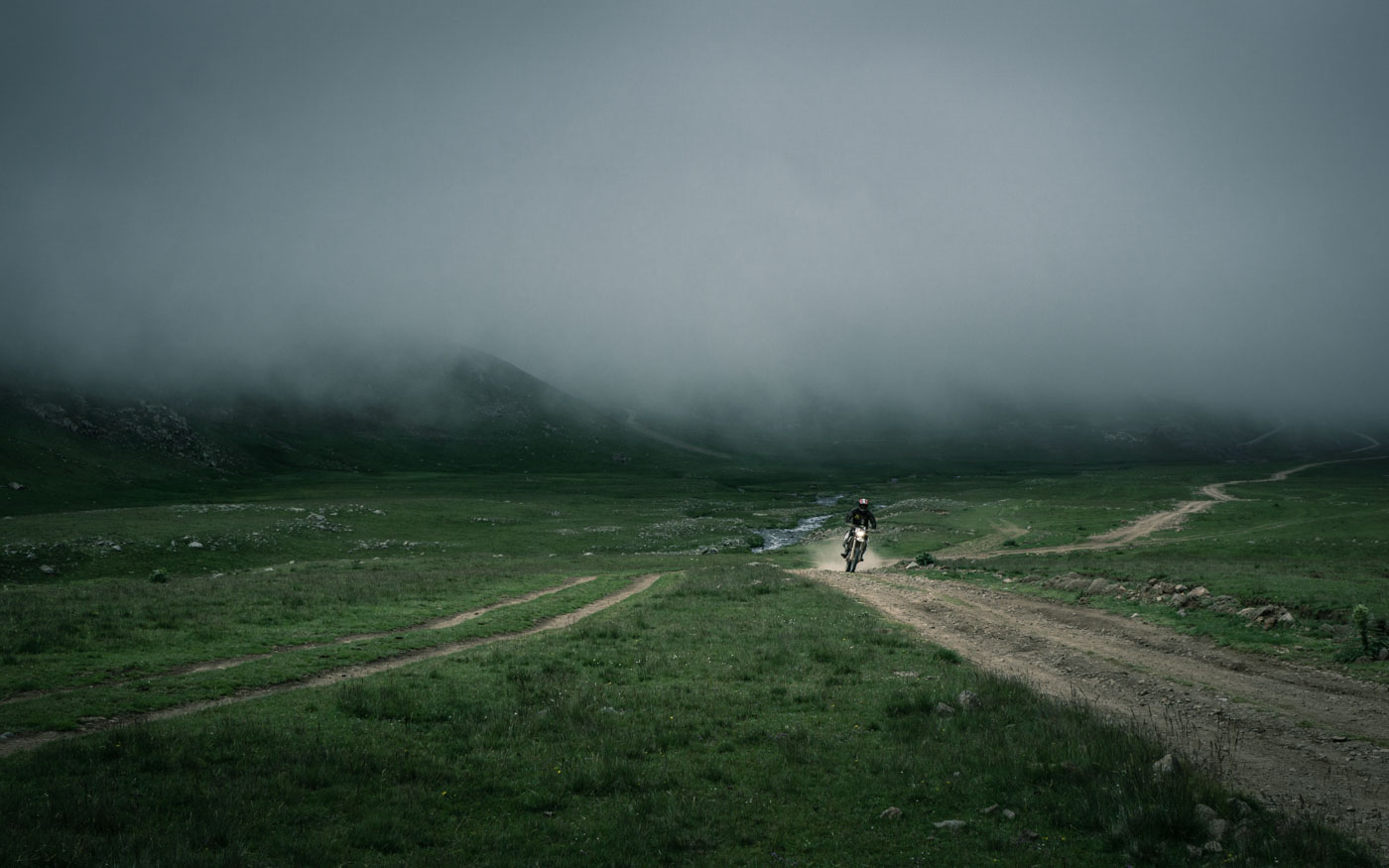
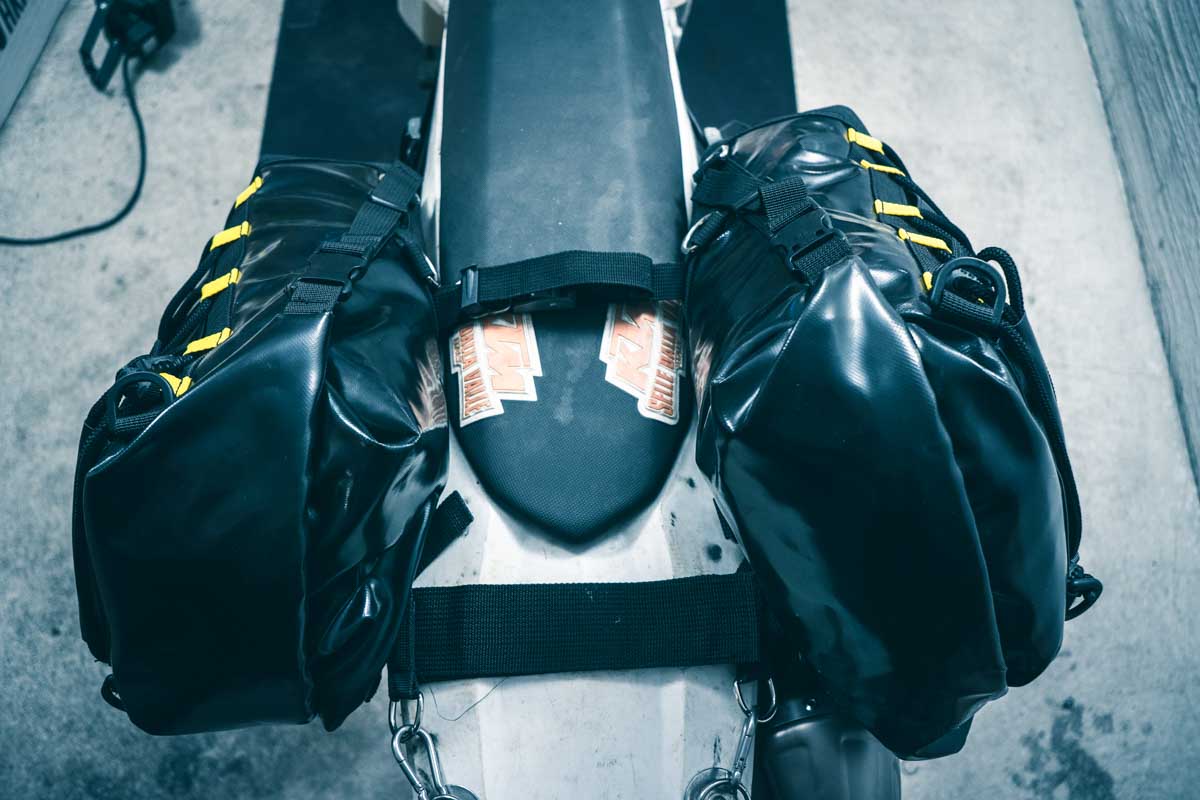
Instead of using an ultra-light tent (with fabrics breaking easily), have you considered using a hammock? E.g. Hennessy Hammock has a wide variety of different models that have also insect nets built-in. Getting sub-1kg might be a problem though…
Hi Ville, I did indeed look into hammocks. They seem like a really great option for wet and muddy conditions as well as mountainous terrain. However, the necessity for trees was a slight issue, as places such as Mongolia don’t really have any. So the hammock would also need the option for ground mounting, which will add to the weight. So I gave up on it for the moment. But were I to go on a ride in the tropics or jungle, I would definitely take another look at hammocks.
Take a look at the Clark Jungle Hammock/Tent combo. It solves a lot of issue with choosing between the two. There is also an upstart called Crua that offers a hybrid that just started shipping.
I use a very similar stove system. I was recently introduced to Esbit and folding stoves that end up being much lighter. Its a cheap option to look at.
Thanks Tom, looks interesting. I did take a look at the Clark Jungle earlier. It seems like a solid option and pretty lightweight for having the tent option.
Hammocks are great but they are made for the tropics not Siberia. I thought I was saving a lot of weight when I left my tent at home and only brought my Eno DoubleNest up into the mountains. I was able to find suitable trees but I froze all night. The cold air underneath you steals all your body heat.
Great article Rolling Hobo. I’m going to try leaving my sleeping pad inside my tent next time I roll it up.
Niles (2014 KTM 690 Enduro)
Los Angeles, CA
Thanks Niles. I came to the same conclusion on hammocks; they’re great for tropics and other warm environments where flat and dry ground is hard to find. I think they’re definitely not the way to go light, as they seem to require more insulation than sleeping in tents and the materials need to be heavier as they need to support body weight.
Have you seen or considered the Jet Boil stove? Lighter than your set up. Comes with a coffee press. Does not need a lighter. It will boil water in 2 minutes flat. I never leave home without it. The smaller unit is perfect for 16 oz of hot coffee on those chilly morning mountain tops.
Jerry (Motomochila- motorcycle back packing)
Hiya Jerry, the Jet Boil is nicely put together and likely gets better fuel economy than the Pocket Rocket. However, as Ron Stibbe pointed out, it is in fact heavier than my current set. I’d love to have the coffee press though. It’s funny, that I never really bothered about item weight too much on climbing or backcountry skiing expeditions, but now on a motorcycle it seems to make a huge difference.
Biltema do a cheap rip off of the JetBoil now. I picked one up for my Norway tour this summer after not being able to find the teal thing anywhere. Worked a treat. Perfect for my essential tea in the mornings and after riding all day.
Thanks Ian, will look into it!
Maybe consider a small ultralight tarp. If you go cuben fiber you can get one ridiculously light and compact. Use it folded up under your tent to protect the floor or rig with some zing-it as a shelter if weather is crap.
Hiya Ron, Cuben fibre rocks. I did consider a tarp that would be hung on the bike and with a minimal support pole at the back. It would have needed some mosquito net for protection from the insects though. Will look into it after the next ride.
Jetboil is way heavier than that setup, and they suck in wind. If your pocket rocket dies, consider replacing with a Soto Amicus. Another option to look into is a twig stove like a Firebox Nano Ti. Uses any available branches and twigs, and can also run on a Trangia spirits burner. The burner fits easily inside your cup and the stove folds up flat
Great tip, I hadn’t seen the Soto Amicus before! It looks very nice and is available in Europe, unlike the Snow Peak LiteMax.
Really nice introduction to camping gears, first time I read about quilt and it really makes sence:) Even though I still drive plus 200 kg bike, 500 exc is bit too extreme for me, I have been minimizing stuff I carry around. It surprices how little you really need, when you are creative. Thanks for sharing your ideas.
Thanks Seppo! I’m glad you’re finding my ramblings useful. Best of luck with all your rides! Terveisin, -j.
Thanks for sharing that
Guilt awesome idea
I ride a 2016 xcw 500
Love it
I use the giant loop Great Basin
Love it
Home made tank bags
And still have to carry a back pack
With the littest but bulkiest thang
My 0 degree sleeping bag
Might have to try a down guilt
Thanks
Turbo
While camping gear is under a fifth of the total mass of my luggage, it takes the most space. It has potential for huge savings in volume, which will make it fit in a smaller space. I ride with 2×15 l panniers and a small mask bag and a small CamelBak. No tank bag…
Thanks for the great write up. I appreciate your innovative approach and critical thinking.
Every person’s needs and every trip is different. As I read your note here’s what comes to mind for me:
1. When I did a lot of solo backpacking, canoeing, mountain hunting and so on, I took to heart advice from Colin Fletcher in his book The Complete Walker. He said it was important to ensure that I a) knew the record high and low temperatures for the area and b) that I had enough reliable gear to be comfortable in average temperatures and to survive in record temperatures.
This sometimes drove me to take a synthetic rather than a down sleeping bag is the area was wet, or do make darn sure that I could keep the down dry no matter what. Once I violated this rule on a solo, summer desert hike where I had only one water container. I felt water dripping from my pack onto my leg and went into a near panic. I discovered it was just overfill but it reminded me I should’ve had two water carriers. Had it spring a fatal leak, it’d have been fatal for me for sure. A few years ago, I was on a solo mountain Elk hunt at 12,000 feet in late October and hunted into the sunset. I now needed to make my way back to my tent on a moonless night in terrain with cliffs in a rising wind and dropping temperatures; it was snowing. My GPS quit working. Like you, I had back-up navigation. I was glad to have a paper map, compass, cordage for tracking my pace count, fire-making materials and spare batteries for my headlamp. While I didn’t expect to need it, I did, and it was the best weight I’ve ever carried.
2. We don’t know what’s too light until we’ve gone past the lower limit; it is lower than most people think. Most people I know who go the ultra-light route in any sport don’t know what the most effective lower-limit is until they’ve gone past it, and then add a bit more weight back in. This may be finding that a creature comfort (coffee) is well worth the weight, and sometimes through an equipment failure – hopefully not too painful.
If your life will depend on ultra-light gear, say in harsh climate, maybe take some less risky trips to be sure it will survive so that you can. In 1980 I had a massive fail backpacking in Norway in September when, exhausted and on a starlight night, I lay my down bag on the ground and went to sleep. I awoke the next morning to find my right side numb. Poking my face out of the sleeping bag I was hit in the face with rain. There were two inches (4cm) of water in my bag; I was lying on my right side. During the night rain had arrived and I was too tired to wake up and apparently got rained on for several hours. My clothes were soaked, my bag was soaked, my pack was soaked, and it was 40 degrees F (4 Celsius). Exhausted from hiking for two weeks in the mountains, I had no physical reserve. Within 30 minutes after packing up, I promptly got life-threatening hypothermia. I was unable to think clearly and barely able to move or use my fingers for anything. Fortunately, I was with some mates, and was medically evacuated. Had I been alone… not good. I was three days inside before I felt warm again.
3. The tent maker’s website said they don’t seal the seams. I avoid the small seam sealing liquid bottles and do this: I buy 3M clear silicone sealant and dissolve it in mineral spirits (unsure what they call it in Europe – “paint thinner” aka Hydrotreated light distillate [petroleum]) and stir like mad until it’s the consistency of glue and just drips from a brush. Then, while the tent is brand new and clean, I erect the tent. Then, I use a cheap, disposable boar’s hair paint brush and brush the silicone mixture on all the seams inside and out. It is clear, flexible, durable, seals well, and much cheaper than the little bottles with sponge tops they sell at the camping store.
4. If it turns out that you need a ground sheet, I use thin Tyvek made for kite making (search Amazon for Tyvek Fabric 1443r 43 GSM). While, as you say, it does have some bulk, it’s pretty light weight (40 grams per square meter), can be washed in a clothes washing machine, is disposable, cheap, and multi-purpose. I find the ultra-light sleeping bag pads benefit from protection, too. When I don’t need the tent and am tired, I just lay it on the ground and put my sleeping pad and bag on top. But not in Norway 🙂
5. For us crazy Americans and for others still on the Imperial measurement system, it would be nice to also have weights in pounds and ounces. While not required, it helps us laggards.
6. Having said all this, it’s a great reminder and challenge to re-examine everything that I take on my motorcycle trips to balance mobility with comfort with safety.
Thanks again and keep up the great work!!!
Hi Bob, and many thanks for your extensive comment. It sounds like you’ve been on some pretty epic expeditions. Especially the Norwegian story sounded brutal, it’s a good thing you had your mates along. I’ve been in Northern Norway for winter climbing and spent around a week in a tent there. Even though the night temperatures were not that much below freezing, the humidity of the open fjords made that expedition one of the coldest I can remember.
I fully agree with your point on temperatures, and I prepare for a miserable night in case the temperature drops to around freezing. It is very unlikely though, and I should be comfortable in the average temperatures throughout summer expeditions. For fall expeditions I would definitely pack a beefier quilt or sleeping bag, and probably carry a tarp instead of a tent as there will be no more insects due to the below freezing nights.
Great tip on the seams. I will need to look into it. Or rather I probably should have already sine I’ve already had the tent for about a year.
As per your request, Imperial units have been added to the post. 😉
Another great article and as ever, really thought provoking!
If I may, I’d like to endorse the use of a Tyvek ground sheet. My rule of thumb is to cut the sheet three time the width of your tent; it can then be used either as a stand alone tarp in reasonable weather if you don’t want more space than the inside of your tent or, if the weather is rubbish or damaged, it can be wrapped completely around the tent to create a ‘double wall’. It’s also a very handy and robust ground sheet if you have to take the bike apart and want to lie it down on a clean surface.
I’m really interested in your approach to reducing the weight of your kitchen. I too like a coffee in the morning (I’m told I’m unbearable in the mornings without one!). Could I ask what sort of food you take that doesn’t need heating up?
Best regards – Rupert
Hiya Rupert, thanks for your tip on the Tyvek sheet. I’m the same way with coffee in the morning; it’s “does not compute error” until the first cup takes effect. 😉
During the day of riding I usually eat a hot meal when refuelling in civilization. At the end of the day I stop to buy supplies for the evening and next morning in camp. My shopping list typically includes 3-5 litres of water, bread rolls, salami, cheese, fresh vegetables and fruit and anything that can be eaten cold straight out of a can i.e. tuna or other fish, beans, pasta in tomato sauce etc. I also buy dried fruit, berries and nuts for the trail next day. I try to stay off chocolate, candy and sweet muesli bars if I can as they tend to make feel a little queasy on the long run. I do occasionally eat salted peanuts or potato chips due to the sweating.
Love your write ups Jussi! Well done on this one, it is another great one!
Great info Jussi , I use the Optimus Crux Stove , less than 100 g and sits in the recess under the gas canister in a wetsuit material pouch , so from a packing perspective takes up 0 L of packing space . http://www.campsaver.com/optimus-crux-stove
Cheers
Alan
Thanks Alan for the great tip. I hadn’t seen the Crux before. Looks very interesting!
Cool , we both got something out of you blogging this subject , I went and bought a Quilt similar to what you have from the same people , exactly what I have been looking for and not too pricey either which is very nice for ultralight camping equipment . Bravo !
Nice setup.Your blog making me definitely downsize.Bike and Equipment.Thinking bout bivvy and like the Quilt idea .Mine thing now is my walking shoes are my wardrobe.
Hiya Robert, camp shoes are usually very bulky and heavy. I decided to go with Kung-Fu shoes. They weigh less than 300 g and pack down very small.
Hi Jussi,
Nice article. I was also going to recommend the Optimus Crux Lite, but I saw that somebody already had beaten me to it. Really nice bit of kit with great power output. You save 10+ grams and I think it will get your water boil a bit faster also. The icing on the cake is that foldable mechanism that makes it fit under the gas canister.
Skjorta rätt ut! (som Anders Eriksson, 7x world champion, brukar säga)
//Erik
Thanks Erik, I’ll try to live by it 😉
check out hammocktent.com With his tarp and the UL gamma (sold out) you’re at around 800g. His version 2 is coming out soon, that he supposedly knocked 100g off. It can be pitched on the ground, but you’d need trekking poles or sticks. Definitely an option. I love mine. Hoping to never sleep on the ground again!
Hi Jim, now this looks very interesting. I like the idea of side suspension; it’ll make for a flatter sleeping position, right?
absolutely. Sleeps very flat and is so comfortable. It’s like an airbed. You could probably use your existing pad too. Also, since he builds the pad sleeve with some slack, you can stuff clothes, riding gear or whatever in it for more insulation and it won’t compress.
I don’t have his tarp. Mine is a custom made by simplylightdesigns.com probably too bulky for your setup, but his tarp would be pretty great for your application. Here’s a video of him pitching it on the ground starting at around 4:00
https://www.youtube.com/watch?v=vZcT7IJhI8A.
I’ll definitely look into those when I’m back. Thanks!
My recent stove favorite is the Solo Stove. I have 3 sizes and like the Titanium for 2 to 4 campers. Fuel is sticks… Not logs, not firewood, but sticks. Also, I don’t like bringing canisters in AND out and I don’t like leaking fuel on my gear. Check them out!
I’m sure they’re great if you have access to sticks, but the seem pretty heavy and bulky though. Having no risk of contaminating other luggage is great though, but it’s ore or less the same with gas too.
Hey great article. There’s lots of good gear out there I rode through the Americas for over 2 years carrying a 500g cubeb fibre tent (zpacks) including ground sheet and pegs.
I’m in need of a good nights sleep and can’t go past the Exped synmat UL7 weighing in at 600gms for the LXW (long extra wide). Insulated internally and inflates to 7cm thick mattress, it is luxury in the size of a 1L plastic bottle.
For cooking I use the Whisperlight International. Carrying canisters is extra weight and if you think you can find compatible canisters in northern Brazil or Guyana, you’ll be sadly disappointed. I carry a 300mL fuel bottle and an outboard primer bulb to pump fuel from my tank, an unlimited resource of cooking fuel.
I don’t have the weights on hand but all my camping gear was tucked into one side of a giant loop Great Basin and the fuel bottle in a bicycle water bottle bracket.
The Whisperlight Intl is nice and reliable, I carry one too if I’m in remote areas, where gas cartridges are scarce. One option would be to go down a size in the fuel tank and carry an extra 2 x 1.5 litres of fuel in MSR bottles along with the Whisperlight. 😉
Hi Hobo,
No longer on facebook, so don’t get to see your updates as much. Big Hi from India (Used to go by ‘Custom Made’ on facebook). Don’t ride a KTM EXC, but I come from the same school of thought. Just wanted to share what I use and ride. Ride a cheap Indian motorcycle (Hero Impulse/NX150 Bros/XR125L etc, Honda call it different names in different markets). The bike is 285 lbs with 10L petrol tools strapped last time I checked. The bike was originally 149cc, but mine is shoehorned to a 240cc motor. All my equipment is from Aliexpress.
Tent – NatureHike Taga 2 person – 1300g (100$)
Sleeping mat – NH inflatable Ultralight – 540g (50$)
Insulation Aluminum Foil EVA ground sheet – 170g (5$)
Spring/Autum sleeping bag (Wildcraft) – 700g (40$)
Don’t carry cooking gear as the Himalayas is filled with monasteries and magnanimous people who will feed you. All of it is 6 Lbs now, ..but now, this article has made me think quite a bit about my choices. Happy trails and shinny side up !
cheers.
Bala
themotorcycleodyssey.blogspot
What do you think about bivies? Like this one: http://m.outdoorgearlab.com/reviews/camping-and-hiking/bivy-sack/outdoor-research-alpine-bivy
Looks like it has the floor and weights less than 1kg. Also there is lighter bivies:
http://m.outdoorgearlab.com/reviews/camping-and-hiking/bivy-sack/msr-ac-bivy
but with some drawbacks on comfort side..
Hi Danil, I used to use bivy bags in sub zero mountain expeditions when it was impossible to pitch tents. Compared to the TerraNova Laser Photon tent, I’d say the only upside of a bivvy bag is the price.
“The greatest concern I have with the tent is the floor.” A trick that I learned from the through-hiker community is using a sheet of household shrink-fit window insulation film as a ground cover. The stuff is tough, moisture just shakes off, and a single tent sized piece packs down and weighs almost nothing. It’s inexpensive as well. I’ve been using the same sheet for a couple of seasons.
Thanks Wayne, I will look into it.
Really nice work @TRH. I am simply amazed at how many people write in to give you some ‘tip’ that turns out to be either obsolete or already bettered by your own reckoning. I find that to be an unfortunate part of the enduro community – too many chefs in the kitchen etc. I find your site an excellent source of information for a beginner like myself. Keep on rolling!
Thanks Paul. I’m always interested in other riders’ solutions and ideas. Dialogue and sharing of ideas makes us all better, but IMHO it’s important to figure out what suits yo specifically, and not blindly take someone else’s ideas as gospel. 🙂
Sorry a bit late to the party since I have only just got into the adventure bike scene after years of ultralight cycle camping. I also use the Terra nova laser tent but use a survival space blanket as a groundsheet protector. Its really tough super light and has a dual purpose which is always a bonus.
Great site for info many thanks
That’ll work. I always carry one too, but haven’t used it as ground sheet thus far.
You might want to check for broken links.
[…] Kelty Late Start 2P Tent, and Alps Mountaineering Helix 2 Person Tent might be just what you need.67 For more interior space and height, some riders might prefer bigger, freestanding tents. Top […]